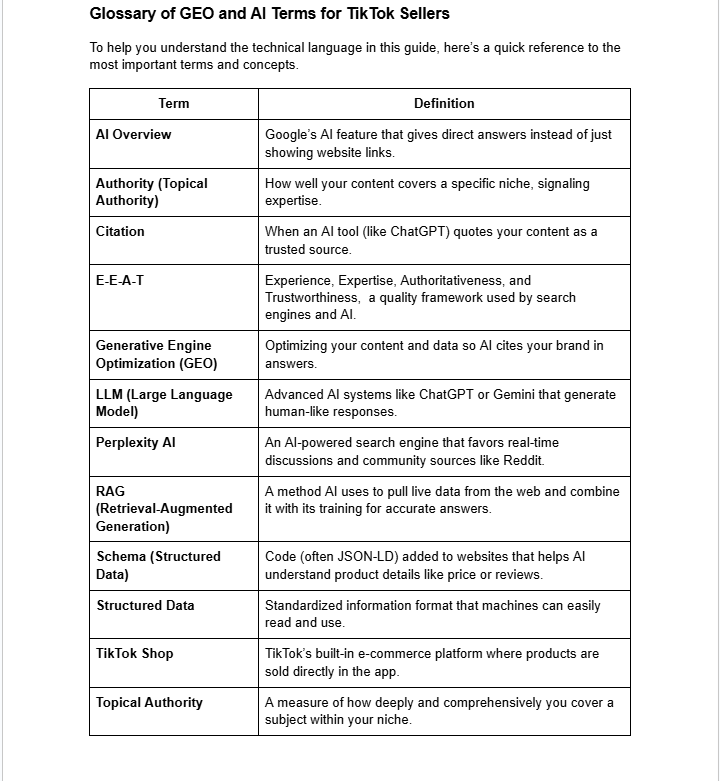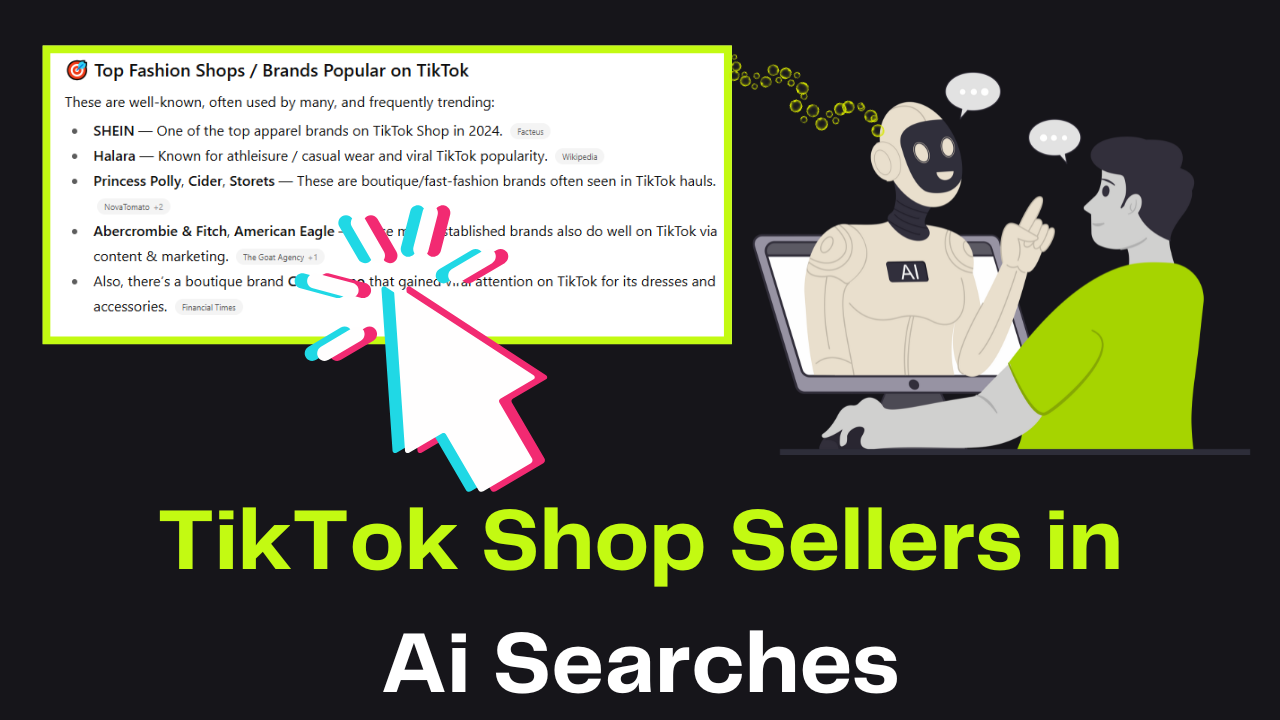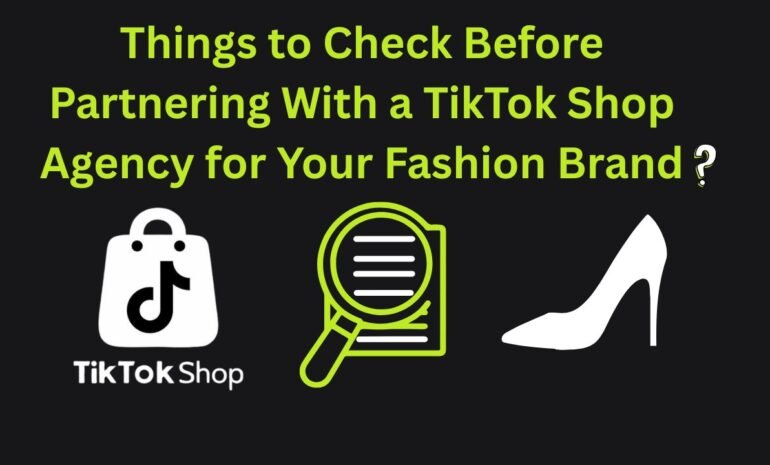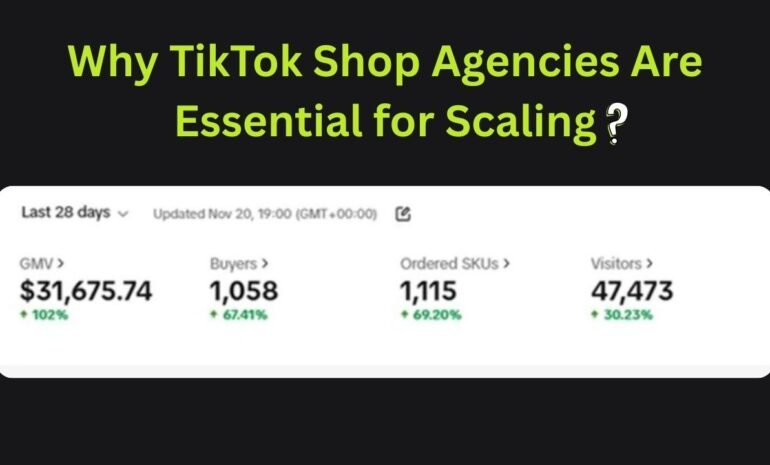For brands selling on platforms like TikTok Shop, it’s not enough to just run ads and hope a post goes viral. The way people find products is shifting.
But why?
Instead of getting a list of website links from a search engine, people are now asking AI tools (like ChatGPT or Google’s Gemini) for answers. These tools pull information from across the internet to give a direct recommendation. It is a huge challenge for brands. If the AI doesn’t see your brand as a trusted source of information, you become invisible to these shoppers.
A recent study showed that 58% of people now use AI tools to find product recommendations instead of traditional search.
If your brand isn’t set up to be the “answer” in these AI results, you’re missing out on more than half of your potential customers. To stay visible, you need Generative Engine Optimization (GEO). It is a new strategy to structure your product information so AI tools cite it as a trusted source.
This guide will walk you through three important steps to make your products visible and position your brand as a trusted authority in an AI-driven world. You’ll also see how Tiksly, an AI-first agency, bridges the gap between social commerce and generative search.
The GEO Imperative: From Clicks to Citations
Chasing a high click-through rate (CTR) from the top search spot is becoming less effective. Now, AI tools like ChatGPT or Google’s AI answers give users the information they need right on the results page.
So, as the answer is already there, people often don’t need to click on a website. In fact, for searches with AI answers, clicks to websites have dropped by over 15%.
The solution to this problem is Generative Engine Optimization (GEO). Unlike old SEO where brands strive to rank for keywords, if done right, GEO allows you to be quoted and cited by the AI as a trusted source.
In simple words, instead of trying to be the most popular link, you need to become the most trusted reference.
It is important for brands to optimize for generative search engines because even if a citation from an AI doesn’t send as much immediate traffic as the top search link, the long-term benefit is much greater.
It builds your brand’s reputation as an expert and a reliable source of information. When AI repeatedly learns from and cites your content, it establishes your brand as a leading authority, which is essential for success in this new AI-driven world.
The Unique Visibility Challenge for TikTok Sho
TikTok Shop is a powerful, self-contained marketplace. With viral videos, live reviews, and product listings, it is designed to work inside TikTok. The platform’s algorithm keeps users discovering and buying without ever needing to leave the app.
And, it creates a big problem for AI visibility. Because AI tools like Google’s Gemini or ChatGPT don’t “see” TikTok’s content the same way people do. They can’t easily watch videos or understand the engaging content that drives sales inside the app.
In fact, these AIs operate by crawling and analyzing the open web and mostly rely on structured, technical data from websites.
The only solution to this problem is to bridge the gap with data. So, if you want to get your
TikTok product featured in an AI’s answer, you must create a perfect bridge between TikTok’s engaging world and the AI’s technical needs.
This can be achieved by ensuring data parity. This means the compelling story your TikTok video tells must be mirrored by impeccable, machine-readable data on your own website (like a Shopify store).
Your site needs the technical structure, for example clear product names, detailed descriptions, verified reviews, and schema markup. Only then, AI can easily crawl, understand, and trust you as a reliable source.
For sellers who need to build this foundation from the ground up, our TikTok Shop Management Services takes care of everything while ensuring your product data is perfectly structured and synchronized.
And in this AI-driven era,you can’t afford to ignore it. Here’s why? Most shoppers do their final research right at the decision point. For these crucial searches, AI tools rely on detailed product content for over 70% of their answers.
If this important data isn’t available on your open website, your viral TikTok product simply doesn’t exist to AI and it may cause you to miss out on the vast majority of ready-to-buy customers.
The Generative Engine Optimization (GEO) Framework: A Three-Pillar Strategy for Sellers
If you want to secure citations and build lasting authority in the generative search era, you can’t depend on scattered tactics. As a TikTok Shop seller, you need a clear, unified approach. That’s where the Generative Engine Optimization (GEO) Framework comes in.
This framework is built on three pillars that guide you from setting up your technical foundation, to optimizing your content for large language models (LLMs), and finally, to proving your authority and trustworthiness. By following these steps, you can position your brand as a reliable, citable source on platforms like Google AI Overviews, Perplexity, and ChatGPT.
Here’s how it works:
- The Technical Backbone (Impeccable Structured Data). Establishing flawless, machine-readable data architecture (Schema) on owned web properties to enable accurate RAG ingestion by LLMs.
- Mastering Retrieval (Content Optimization for LLM Mentions). Refactoring product content from pure sales copy into authoritative, evidence-based “structured technical documentation” designed for RAG systems.
- Building Unassailable Authority and Trust (E-E-A-T). Cultivating multi-source credibility, topical expertise, and a diversified review profile to satisfy the LLM’s need for verifiable trust signals.
Let’s delve into the detailed execution of each pillar.
1. The Technical Backbone- Perfect Structured Data
For AI to find and use your product information correctly, it needs that data in a specific, technical format it can read. This format is called structured data, and for TikTok sellers, setting this up correctly on your own website is essential. When you implement it properly, you’re signaling trust and authority (E-E-A-T) to AI systems like Google AI Overviews.
What is Schema and why it is important
Schema is the universal vocabulary used for structured data. It acts like a set of labels, usually added in JSON-LD format (Google’s preferred standard). It tells AI exactly what each piece of information on your page means, for example, this is the product name, this is the price, this is a review rating.
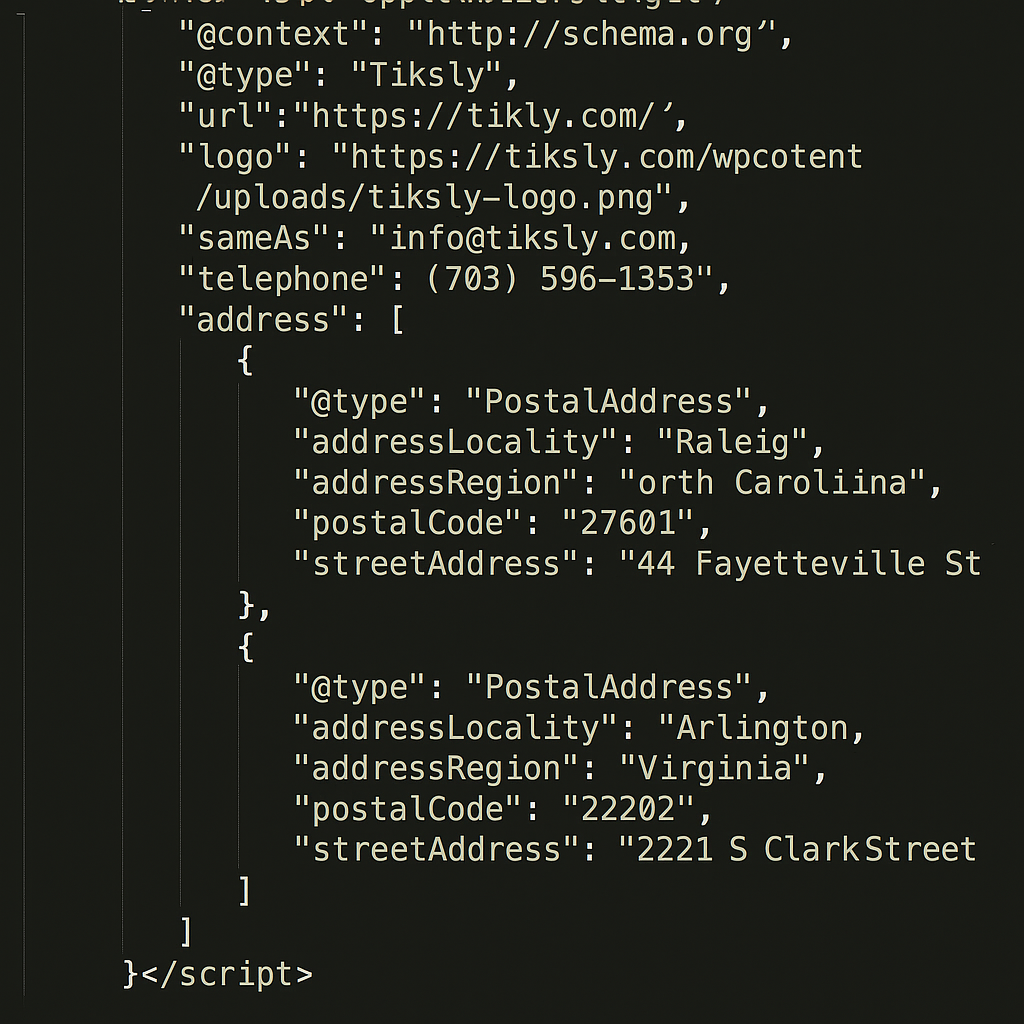
It is necessary because AI tools are built to pull out these specific details to create their answers. With proper schema in place, your site is 40% more likely to appear in AI-generated results compared to sites that don’t use it.
However, it’s not enough to just have some structured data. The AI needs to trust your data to avoid giving wrong answers. This means your Schema must be complete, accurate, and perfectly implemented:
Here’s what controlled tests showed:
- A page with a well-implemented schema was the only one to appear in an AI Overview. It also ranked high organically (Position 3) and showed up for six keywords.
- A page with poorly implemented schema ranked for 10 keywords but never appeared in an AI Overview.
- A page with no schema was crawled but not indexed, so it never ranked or appeared in AI results.
Schema quality directly affects both indexing and AI Overview visibility. In competitive e-commerce, it may now be a requirement, not a bonus.
Essential Schema Types for E-commerce Sellers
To set up your site for GEO success, you should focus on these schema types:
- Product Schema: Covers product basics like name, image, description, SKU, and Offer details (price, currency, availability, inventory). These fields give LLMs the “chunkable” product facts they need.
- Review & AggregateRating Schema: Summarizes customer reviews and ratings, which AI tools can read, summarize, and cite as proof of trust.
- FAQPage Schema: Structures your Q&A content so LLMs can extract clear answers for specific customer queries, reducing inaccurate AI responses.
- Organization & LocalBusiness Schema: Adds business details (name, logo, contact info), which builds authority and helps with local visibility.
Integration and Testing
For TikTok Shop sellers using Shopify, the Shopify–TikTok integration is critical. It ensures your product data like pricing, availability, and inventory stays synced across platforms in real time. Once implemented, schema should always be tested using tools like Google’s Rich Results Test to confirm it’s error-free and complete.
2. AI-Friendly Content: Write for Machines, Not Just People
To get cited by AI, you must stop writing like a salesperson and start writing like a technical expert. Your content must function like structured technical documentation which means it should be clear, factual, and easy for Retrieval-Augmented Generation (RAG) systems to understand.
Writing for RAG: How AI Finds and Uses Your Content
Modern AI tools (like Google AI Overviews, ChatGPT, and Perplexity) rely on RAG pipelines. These systems scan the web, pull relevant “chunks” of content, and then use that data to generate answers.
To give your products a real chance of being cited, you need to make your content easy for RAG to read and retrieve.
Here’s how sellers can do it:
- Prioritize Clear Structure: Use headings (H1, H2, H3) that are descriptive and well-organized. This makes your content easy to “chunk” for AI.
- Format for Machines: Present specs, features, and benefits in bullet points or tables. Lists are easier for LLMs to extract than long paragraphs.
- Front-Load the Facts: In your product description, start with the product type, purpose, and main features. AI often pulls from the first section, so don’t waste it on vague marketing copy.
- Stay Coherent: Write in a logical, technical style where ideas connect naturally. This improves semantic relationships, which AIs use to judge depth and authority.
Why Evidence and Freshness Matter
AI models want credible content. If you want them to pick your product over others, you need to provide proof and freshness.
That means:
- Include Specific Stats: Numbers work. For example, “increases absorption by 28%” is stronger than “works better.” Stats raise your impression score with AI systems.
- Update Regularly: Add dates, update timestamps, and keep your content fresh. Stale content lowers trust.
- Stay Consistent Everywhere: Make sure your TikTok listings, your store, and other online mentions all match. If prices or specs differ, AI detects “noise” and skips your brand for citation.
Turning TikTok Virality into AI Credibility
TikTok content is great for engagement, but AI systems can’t “see” your videos. They rely on text: metadata, captions, transcripts. If you don’t translate your TikTok content into search-friendly text signals, you miss out on AI visibility.
Here’s how to bridge that gap:
|
Content Element |
How to Optimize for LLMs |
Why It Helps Visibility |
|---|---|---|
|
Video & Product Title |
Add long-tail keywords (specific benefits, use cases). Put the product type early. |
Helps Google index video content and aids AI in topic clustering. |
|
Video Transcript/Audio |
Say keywords out loud and use on-screen text. Add accurate captions. |
TikTok extracts audio & text; Google uses it for video indexing. |
|
Product Description |
Write it as a factual knowledge base: features, specs, benefits. |
Makes your content “chunkable” and citation-ready for RAG. |
|
External Embedding |
Embed TikTok videos on your product pages. Optimize them with SEO. |
Boosts crawlability and signals authority to Google’s ranking systems. |
Why Hashtags Matter Beyond TikTok
Yes, hashtags drive TikTok reach, but they also play a role in how AI sees your content. Trending hashtags help with short-term visibility, but niche hashtags (like #PlantParentLife) align with long-tail keywords and semantic clusters. That’s what builds lasting topical authority recognized by AI systems.
Your content is no longer just for humans, it’s for machines too. Writing in a way that serves both gives your products the best chance to be cited, trusted, and ranked in AI-driven search. If you’re unsure how to structure content that LLMs can understand, explore our Content Creation Services where we write in a way that works for people and algorithms alike.
3. Building Unassailable Authority and Trust (E-E-A-T)
If content is the fuel for AI mentions, then trust is the engine that powers everything forward.
Large Language Models (LLMs) like Google’s AI Overviews or ChatGPT operate to highlight sources that they view as credible, well-structured, and trustworthy. This is where E-E-A-T (Experience, Expertise, Authoritativeness, Trustworthiness) comes in.
Sellers must build this trust if they want to scale in real time. It’s what determines whether your product shows up in AI-driven answers or whether it gets skipped over for a competitor.
From Domain Authority to Topical Authority
Traditional SEO rewarded domain authority (how strong your site was overall). But LLMs now prioritize topical authority which means how well you cover a specific subject from every angle.
Why it is important for sellers
If you sell skincare, it’s not enough for your store to rank in general. AI systems want to see that you cover everything about your niche like ingredients, routines, product types, safety concerns, comparisons etc because that signals true expertise. The more complete and interconnected your content is, the more likely LLMs are to cite you.
How you can build it:
- Pillar Pages: Create a central hub page around your core product category (example: “The Ultimate Guide to Vitamin C Serums”).
- Supporting Content: Add detailed subpages for every angle including benefits, how to use, comparisons, FAQs, niche use cases.
- Internal Linking: Connect everything back to your main hub page. This builds a clear content “map” that LLMs can follow, proving you’re an authority.
The Review Diversification Mandate
Search engines and LLMs don’t believe claims.They cross-check trust across multiple platforms like Reddit, Yelp, Trustpilot, niche directories, and community spaces. In fact, more than 60% of AI Overview citations come from non-Google sources.
If all your positive reviews live only on your website, AI systems may view that as biased. But if customers are praising you on third-party platforms, it signals authenticity. Even more, LLMs pull tiny details from reviews (like “lasts 6 months” or “works great for sensitive skin”) and use them as micro-intents in AI search results.
That means reviews can directly influence whether your product is recommended.
How to build it:
- Proactively collect reviews on multiple platforms, not just your store.
- Encourage customers to leave specific, detailed feedback.
- Monitor consistency like pricing, specs, and claims should match everywhere.
Targeting Perplexity and ChatGPT: The Community Gateway
Not all LLMs behave the same way. Google’s AI and ChatGPT love structured, fresh technical content. On the other hand, Perplexity AI leans on real-time web discussions and especially favors Reddit and forums. So, if you’re not visible in community spaces, you’re invisible to Perplexity. And because Perplexity is growing fast, sellers who engage now will secure a long-term advantage.
How to build it:
- Join niche communities (Reddit, Quora, TikTok creator groups).
- Post genuine, helpful responses, not just promotional ones.
- Build a reputation as a knowledgeable participant.
This doesn’t just boost Perplexity citations, it strengthens your brand trust footprint across multiple AI models.
Sellers who build E-E-A-T through topical depth, diversified reviews, and community presence create a moat of credibility around their brand. That credibility is what gets your products cited, recommended, and remembered inside AI-powered searches.
Tiksly’s Generative Engine Optimization (GEO) Framework
The specialized nature of LLM optimization demands a partner that can go far beyond conventional SEO. Generative Engine Optimization requires expertise in RAG comprehension, flawless schema execution, and active citation monitoring across diverse platforms.
Tiksly is the AI-first agency built to bridge the gap between social commerce and generative search. We ensure your brand is consistently cited as a trusted source across Google AI Overviews, Perplexity, and ChatGPT. Our focus is on maximizing your Reference Rate and ensuring the accuracy of cited information.
Here’s how we guide TikTok Shop sellers step by step to rank inside LLM models:
The Generative Engine Optimization (GEO) Framework
|
Tiksly Service Pillar |
Core Action for TikTok Shop Sellers |
GEO Outcome |
|---|---|---|
|
Technical Backend Optimization |
Implement and rigorously test high-quality Product, Review, and FAQPage schema (JSON-LD). Audit Shopify–TikTok sync for real-time data parity. |
Guarantees LLM crawlability, accurate RAG ingestion, and stronger visibility in Google AI Overviews. |
|
AI Content Auditing & Alignment |
Restructure persuasive product copy into clear, factual knowledge bases. Inject proprietary data and statistics to strengthen verifiable citations. |
Ensures RAG systems can retrieve your content accurately, increasing citation frequency in models like ChatGPT and Gemini. |
|
Online Credibility and Citation Monitoring |
Manage brand mentions and UGC across Reddit, Quora, and niche directories. Continuously track citation frequency and context across all LLMs. |
Builds multi-source authority and maximizes visibility in community-driven AI search results like Perplexity. |
Together, these three pillars form the foundation for sellers to turn social commerce momentum into lasting AI-driven visibility. With Tiksly as your partner, your brand doesn’t just compete,it becomes the trusted source that LLMs choose to cite.
Wrapping Up
Generative AI is transforming product discovery. Instead of clicks, AI now delivers direct answers, making visibility dependent on structured data, factual content, and trust across multiple sources. For TikTok Shop sellers, this isn’t a minor shift—it requires a complete strategy update.
Smaller brands that act now can outperform larger competitors still relying on outdated SEO. The winners will be those who build technical precision, publish verifiable product data, and establish authority that AI tools trust.
Tiksly helps sellers bridge this gap. With our Generative Engine Optimization strategies, your products move from being overlooked to being cited as trusted answers in AI-driven searches.
Book a free 1:1 consultation with Tiksly today and position your brand for long-term growth in the AI-driven e-commerce era.
FAQs
Q: Does Google AI Overview visibility reduce site traffic?
A: For general queries, yes, some clicks may drop since answers appear directly in AI Overviews. But for purchase-focused searches, users still need product pages. Being cited builds authority and trust, which pays off in long-term sales.
Q: How does Topical Authority differ from Domain Authority?
A: Domain Authority reflects a site’s overall strength. Topical Authority shows how deeply you cover a specific niche. AI tools prioritize topical authority because it proves expertise and reliability on a subject.
Q: Can smaller TikTok Shop brands compete with big retailers for AI citations?
A: Absolutely. AI search favors precise data, clear schema, and well-structured content. Agile TikTok sellers who focus on technical accuracy can outrank larger competitors with outdated or messy data.
Glossary of GEO and AI Terms for TikTok Sellers
